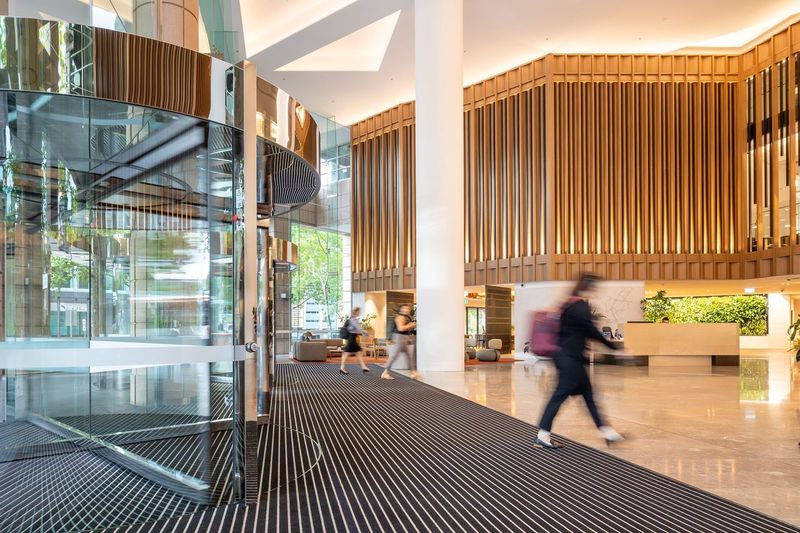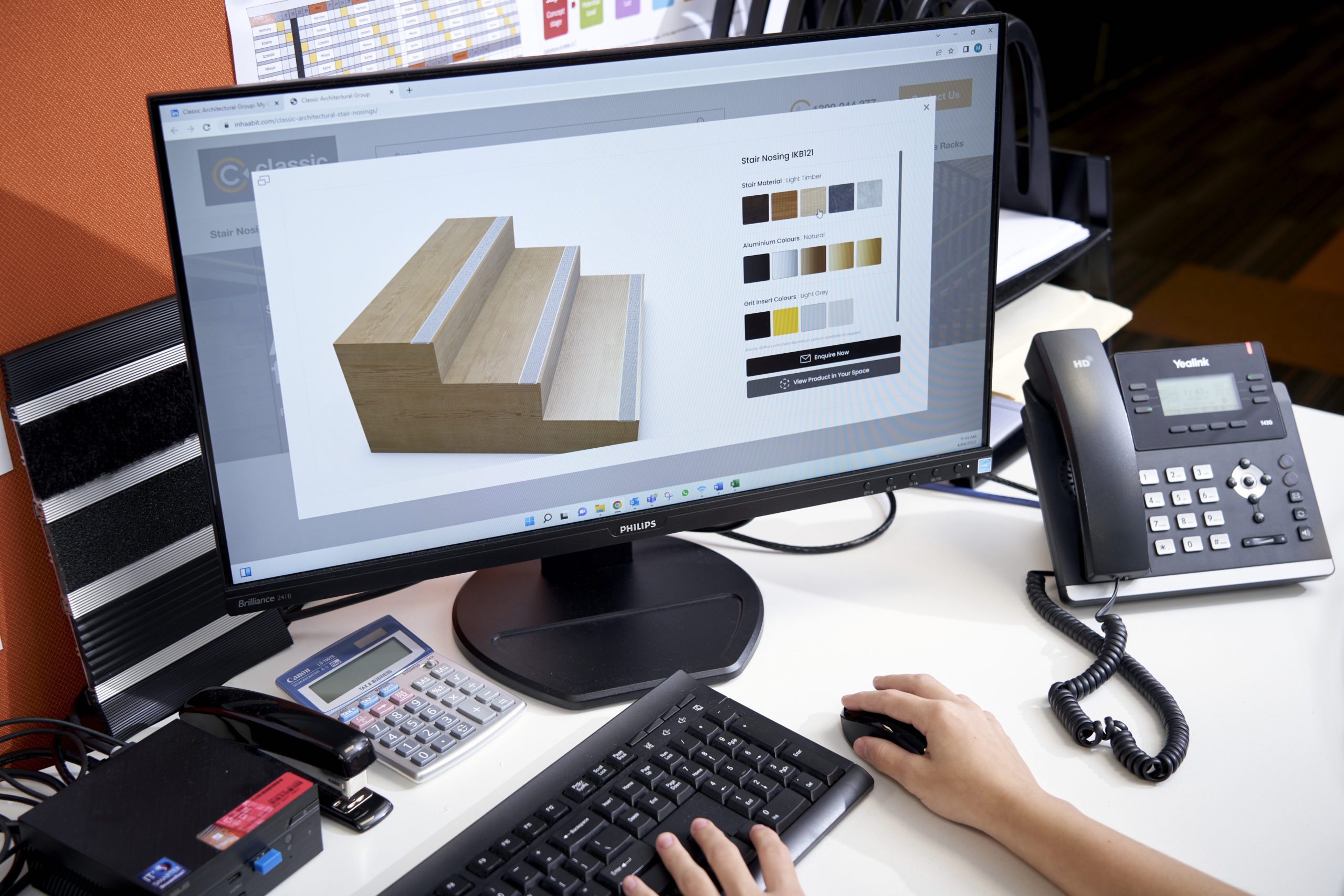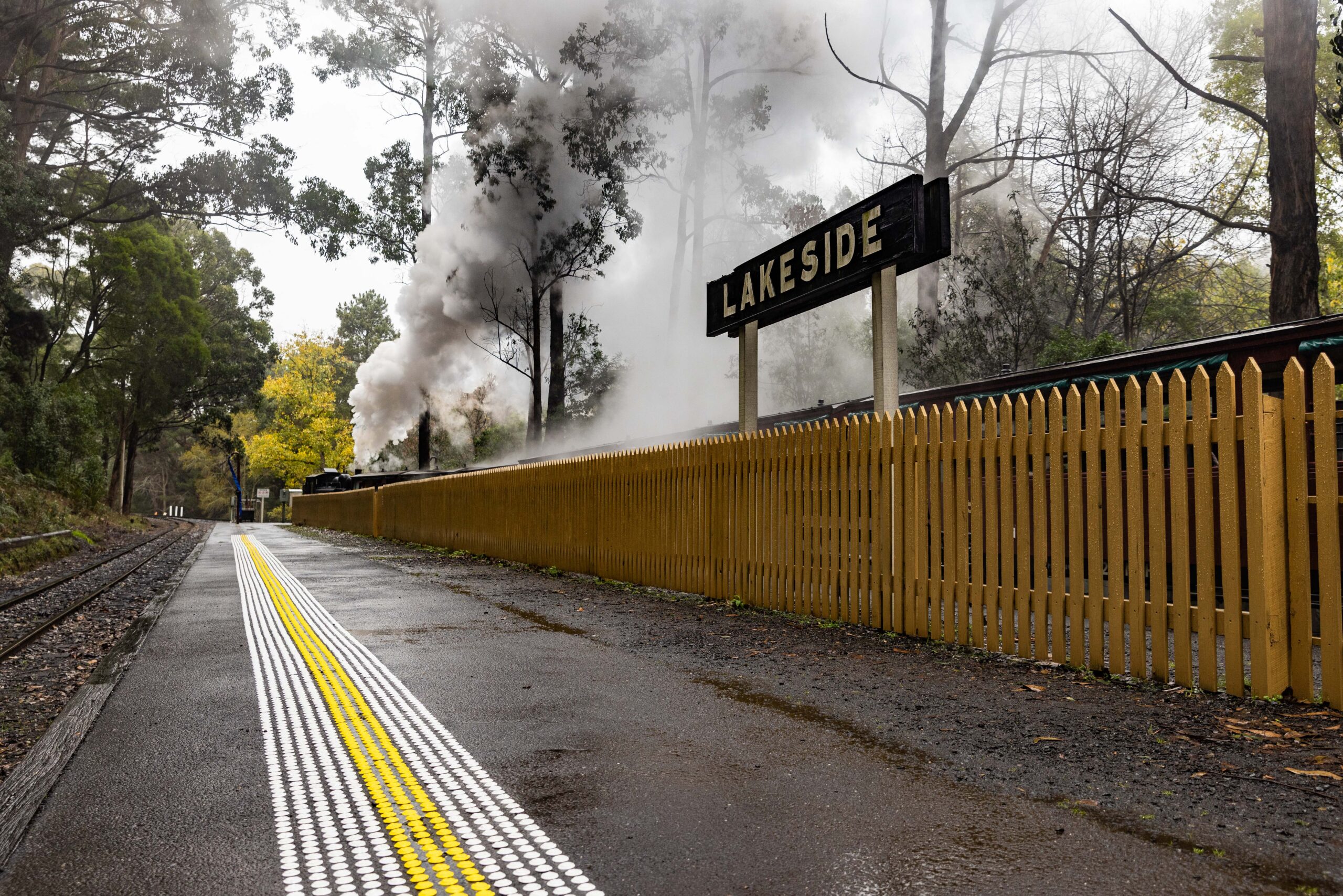Where Safety, Accessibility & Initial Impressions Come First
Entrance matting is a critical requirement for any public building, often installed at common entry points to minimise the risk of slips, trips, and falls.
As one of the first architectural elements visitors encounter, entrance mats are essential for trapping moisture and debris at the door, playing a pivotal role in maintaining public health and safety while preserving the cleanliness and longevity of your building’s interior.
Most importantly, installing compliant entrance matting not only ensures that your project adheres to Australian Standards, but also proactively reduces the risk of legal liabilities and financial penalties associated with non-compliance. It also showcases your dedication to creating safer, more accessible environments for all users, especially those with disabilities.
By supporting inclusivity and ensuring compliance with regulations like the Disability Discrimination Act (DDA), compliant entrance matting helps foster a more welcoming and accessible environment for everyone.
In this article, we’ll explore the different types of commercial entrance matting and various applications to help ensure compliance with the relevant codes and standards.
Let’s Explore the Different Types of Entrance Matting
Commercial entrance matting can broadly be categorised based on zones and application methods, with each type serving a specific purpose to ensure optimal performance and safety.
Based on Zone
- Zone 1 – Exterior Entrance Matting:
Designed to withstand outdoor elements like rain, heat, and varying weather conditions, exterior mats must have strong scraper properties to remove heavy soil, mud, and debris from footwear before entry. Open construction mats allow debris to fall through, keeping the surface hazard-free. These mats are durable and weather-resistant, making them essential for the initial cleaning process. - Zone 2 – Primary Interior Entrance Matting:
Positioned just inside the entrance, primary interior matting continues the job of exterior matting by removing finer debris such as soil, grit, and moisture. It’s tough and durable to handle heavy foot traffic, preventing damage to the interior flooring. This type of matting is critical for maintaining safety and cleanliness inside the building. - Zone 3 – Secondary Interior Entrance Matting:
This matting is located further inside and serves as the final step in the cleaning process, focusing on drying shoes and removing any remaining dust and fine particles. It ensures that moisture and dirt don’t spread throughout the building, keeping interior spaces clean and reducing the need for constant floor maintenance.
Based on the Application Method
- Recessed Entrance Matting:
Recessed mats are installed within a matting well, sitting flush with the surrounding floor for a seamless look. Popular in commercial buildings, recessed systems are durable and provide a high-end appeal. Their flush design reduces trip hazards and ensures the mat stays securely in place, making them ideal for high-traffic areas. - Surface-Mounted Entrance Matting:
Surface-mounted mats are installed directly on top of the existing floor and feature a tapered edge to eliminate trip hazards. These mats are quick and easy to install, offering excellent performance in removing grit and moisture. Surface-mounted mats are a practical solution when recessed installations are not feasible.
Based on Format/Specification
- Customised Entrance Matting:
Custom entrance mats can be tailored to suit the unique needs of a business, from custom sizing and shapes to logo features and specific material inserts. These versatile mats can be designed to fit new or existing interiors, offering both functional and aesthetic benefits. - Roll Out Entrance Matting:
This type of matting is easy to roll up for quick cleaning, making it a convenient solution for businesses that require fast installations and simple maintenance. Roll-out mats are flexible, offering ease of use without compromising on performance. - Modular Tile Entrance Matting:
Modular tiles offer a soft, plush feel underfoot and are cost-effective for businesses. These mats can be specified to exact size and design requirements, and individual tiles can be replaced when needed, reducing maintenance costs by eliminating the need to replace the entire mat system.
Choosing the right type of entrance matting based on these zones, application methods, and formats ensures that you can maintain your building’s safety, cleanliness, and compliance while enhancing the aesthetic appeal of entrances.
Understanding the Relevant Australian Standards and Codes for Entrance Mats
In Australia, commercial entrance matting must adhere to relevant Australian Standards and building codes to ensure safety, durability, and performance.
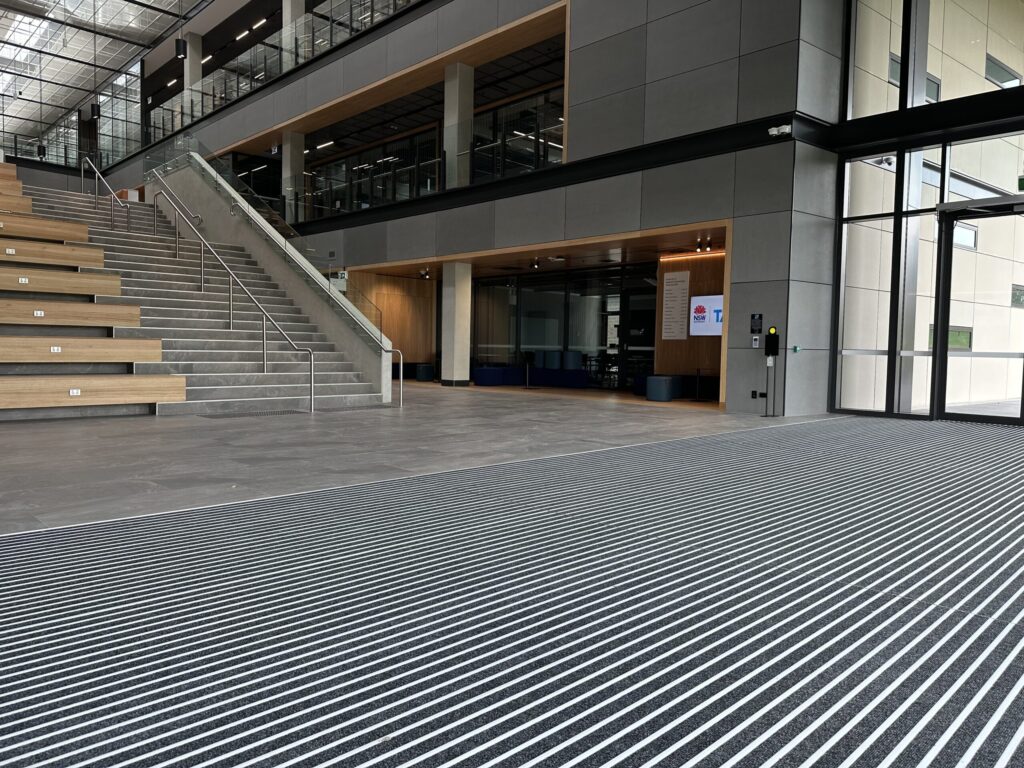
While there is no specific Australian Standard solely for entrance matting, the following standards and guidelines apply to the materials, installation, and performance of entrance mats in commercial settings:
- AS1428.1:2021 – Design for Access and Mobility
This standard focuses on ensuring accessibility for people with disabilities. It outlines provisions to guarantee that entrance matting does not create barriers or impede access for individuals with mobility impairments. For example, mats must have a low profile to accommodate wheelchairs and walkers, and be securely affixed to prevent tripping hazards.
- AS4586:2013 – Slip Resistance Classification of New Pedestrian Surface Materials
While the NCC does not specify slip resistance requirements for entrance matting, it requires floor surfaces to have adequate slip resistance to minimise the risk of slips and falls. This standard provides a method for testing and classifying the slip resistance of pedestrian surface materials.
- Fire Safety (NCC 2022 Fire Resistance – Class 2 – 9 Properties of Floor Material and Coverings)
The NCC includes fire safety provisions that specify the fire resistance ratings required for floor materials and coverings. Entrance mats, especially in high-traffic commercial areas, must meet these fire resistance standards to prevent hazards and ensure safety in the event of a fire.
- Disability Discrimination Act (DDA)
While the DDA doesn’t provide specific requirements for entrance matting, it mandates that buildings and facilities ensure reasonable access for people with disabilities. This overarching regulation emphasises that entrance mats should not obstruct safe access for individuals with disabilities, reinforcing the importance of compliance with AS1428.1 and ensuring accessibility for all.
These standards and guidelines help ensure that commercial building entrance matting complies with legal requirements, providing a safe, accessible, and inclusive environment for all users.
For a more comprehensive guide, please download Classic’s up-to-date Entrance Matting Compliance Guide.
Common Applications Requiring High Compliance
Public Spaces
Due to the high volume of foot traffic, entrances to public spaces, such as shopping malls, airports, hospitals, hotels, and government buildings, must meet stringent safety standards.
Public building entrance mats must be highly durable and slip-resistant to handle continuous use while effectively managing moisture. This helps prevent hazards and maintain safety for all visitors.
Schools & Education Facilities
In schools, compliance ensures the safety of students, staff, and visitors. Entrance mats in these facilities must absorb moisture and trap dirt, especially during wet weather, to reduce the risk of slips.
Maintaining slip resistance in high-traffic areas like hallways and entrances is essential to ensuring safety throughout the school year.
Commercial Offices
Businesses are often subject to workplace health and safety audits, so compliant office entrance mats are crucial. Slip-resistant, moisture-absorbing mats at office entrances reduce the risk of workplace accidents, improving safety and reducing liability.
Proactively maintaining a clean and presentable entrance also enhances the company’s professional image.
Aged Care & Disability Facilities
Accessibility is a priority in aged care and disability facilities. Entrance mats in these spaces must comply with mobility standards, ensuring they don’t obstruct the movement of wheelchairs, walkers, or other aids.
Mats should have a low-profile edge to allow easy transitions and remain securely in place to prevent tripping hazards. Durable, slip-resistant mats ensure the safety of all residents, staff, and visitors, particularly during wet conditions.
Benefits of Compliant Entrance Matting
Compliant entrance matting offers numerous benefits for enhancing safety, accessibility and overall building maintenance, particularly in commercial and high-traffic settings.
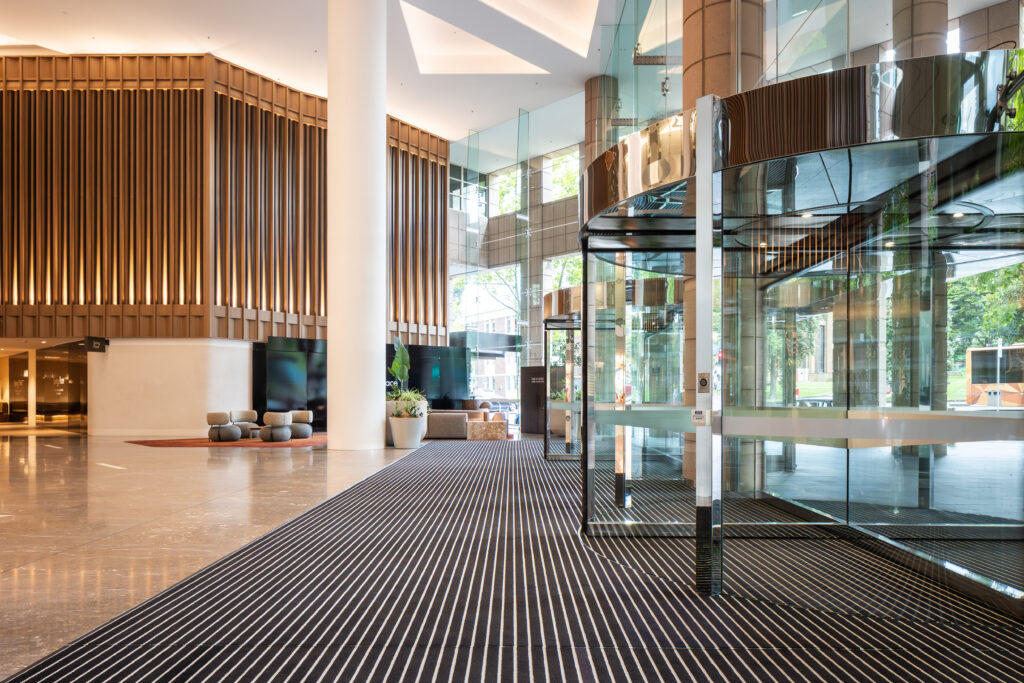
Here are the key benefits:
- Improved Health & Safety: Installing slip-resistant, compliant mats reduces the risk of slips, trips, and falls, particularly in wet weather and high-traffic areas. They can also help to improve air quality by minimising the spread of dirt, dust and allergens into the building.
- Enhanced Accessibility: Choosing compliant mats in the correct size, design, and thickness ensures smooth transitions for people using wheelchairs, walkers, and other mobility aids.
- Extended Flooring Lifespan: By trapping moisture, dirt, and debris at the door, compliant entrance mats help to protect the flooring, preventing damage and wear over time.
- Reduced Cleaning & Maintenance Costs: Acting as a barrier to trap first and moisture at the entrance, commercial entrance mats lessen the need for frequent cleaning and maintenance of interior flooring over time.
- Building Presentation: Compliant mats help to maintain the overall appearance of the building by keeping the floors clean, which leads to enhanced brand reputation and visitor satisfaction.
Examples of Non-Compliance Issues to Avoid in Commercial Settings
- Insufficient Slip Resistance: Entrance mats with insufficient grip can increase the risk of slips and falls, particularly in wet conditions, failing to meet safety standards.
- Incorrect Mat Thickness: Mats that are too thick can interfere with the operation of entrance doors while failing to provide a smooth transition for visual or mobility-impaired individuals.
- Incorrect Sizing or Placement: Mats that are too small or poorly placed may result in insufficient moisture absorption and dirt removal, increasing the risk of slips and falls.
- Inadequate Securing: If the mat is not anchored correctly, it may shift, move, or bunch up and become a tripping hazard.
- Lack of Maintenance: When mats are not cleaned and inspected regularly, debris, dirt, and moisture can accumulate, reducing their performance and leading to inadequate protection or slip resistance.
- Worn or Damaged Mats: Over time, entrance mats can wear down, lose their slip resistance, or become uneven. This can lead to buckling, curling, tearing, or lifting at the edges, creating tripping hazards.
Non-compliant entrance matting can lead to safety and accessibility issues, potentially resulting in costly legal consequences.
5 Steps to Help You Select Compliant Entrance Mats
Once you’ve thoroughly reviewed the general access requirements for buildings in commercial settings, as outlined by the Australian Standards (AS 1428.1), you can then choose entrance mats that not only ensure compliance but also enhance safety and functionality.

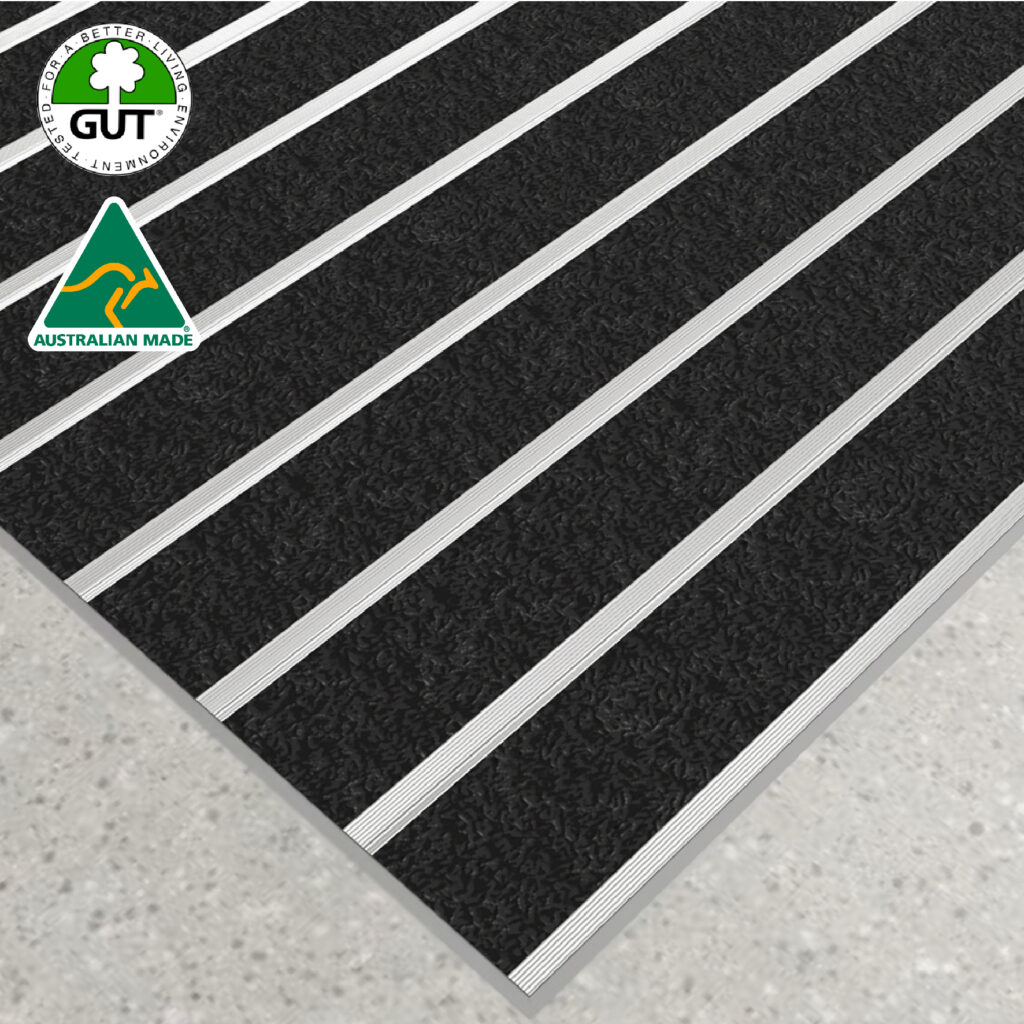
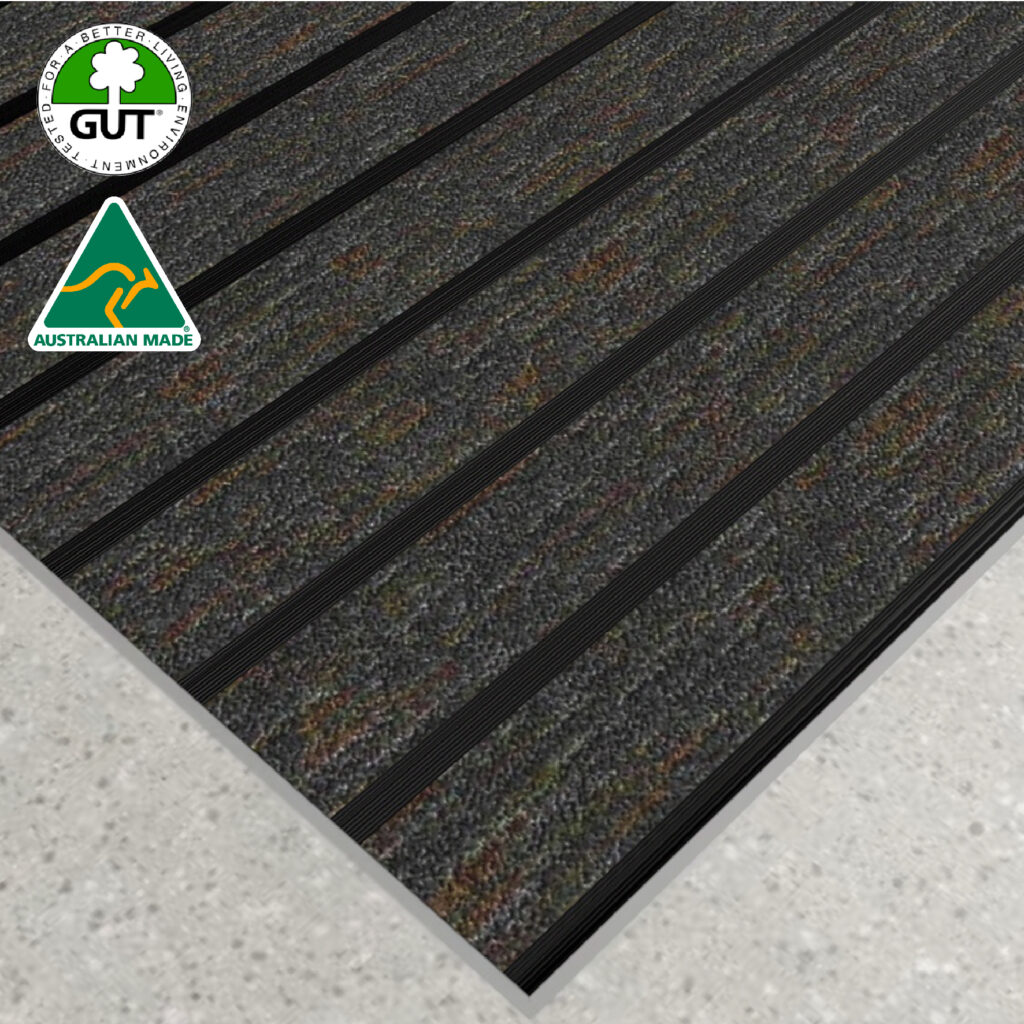

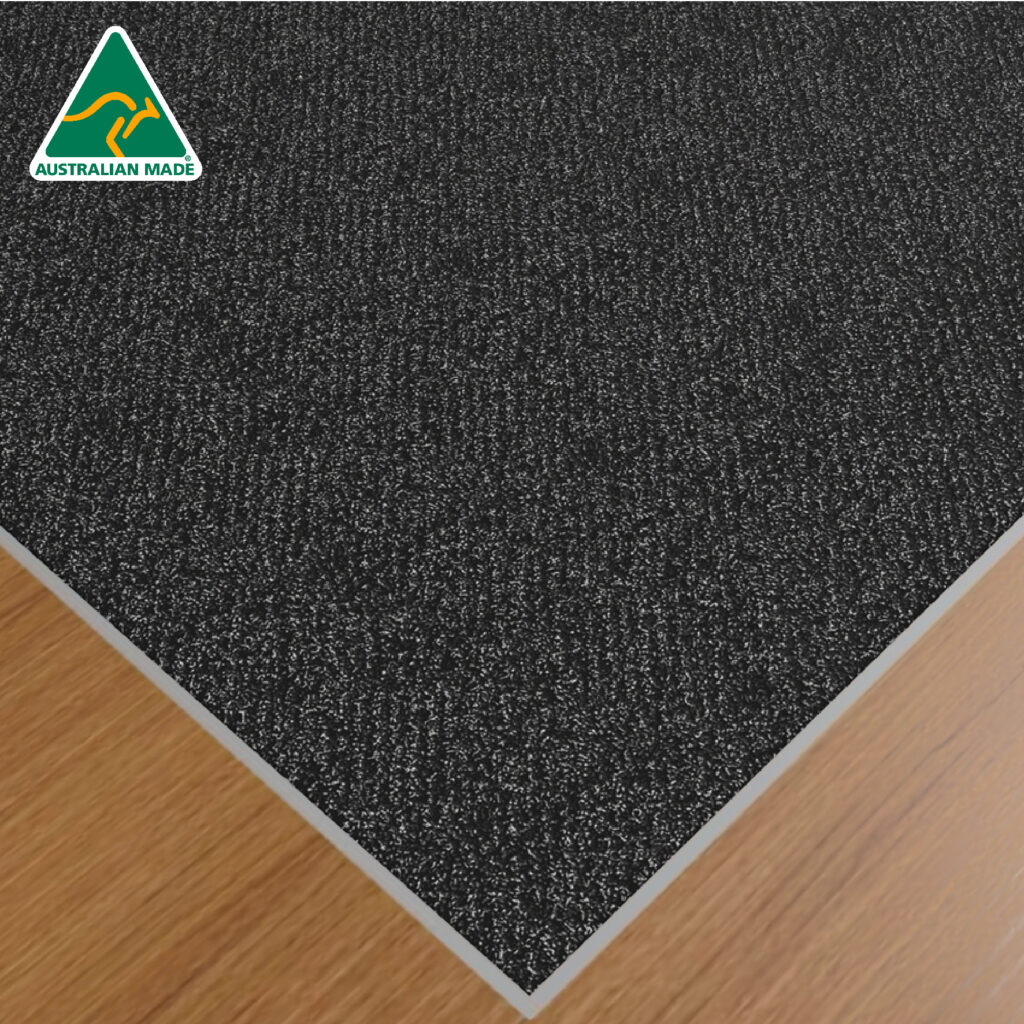
While we recommend speaking to one of our friendly specialists about your commercial entrance matting requirements, below is a simple five-step guide to help you get started.
Step 1: Consider Expected Traffic Levels
Low-Traffic Areas
In low-traffic areas, such as private entrances or small shops, we recommend selecting low-traffic area matting with a P3 slip-resistance rating. P3 offers a moderate level of slip resistance suitable for most general-purpose areas in low-traffic settings.
High-Traffic Areas
In busier settings, such as hospitals, shopping malls, and commercial buildings, we recommend high-traffic area matting with a P4 or P5 slip-resistance rating. These locations experience heavier traffic, subjecting the matting to increased wear and tear, so the higher level of slip resistance ensures durability.
Step 2: Select the Material
To ensure performance, materials such as rubber, vinyl, and commercial-grade carpet offer enhanced moisture absorption, quick-drying performance and durability, preventing water from pooling and reducing the risk of slips while helping protect the flooring.
AS1428.1 recommends that floor surfaces have a consistent and detectable texture to aid people with vision impairments in navigating the environment safely.
Where carpets or any soft, flexible materials are used on the ground or floor surface, the pile height or thickness should not exceed 11mm, while the carpet thickness should not exceed 4mm. The combined dimensions of the backing and pile must be a maximum of 15mm.
Step 3: Determine the Design
For low-traffic areas, entrance mats should have anti-slip backing to prevent the mat from moving under foot or wheeled traffic. On the other hand, recessed or modular commercial mats would be ideal for high-traffic settings to avoid buckling or shifting.
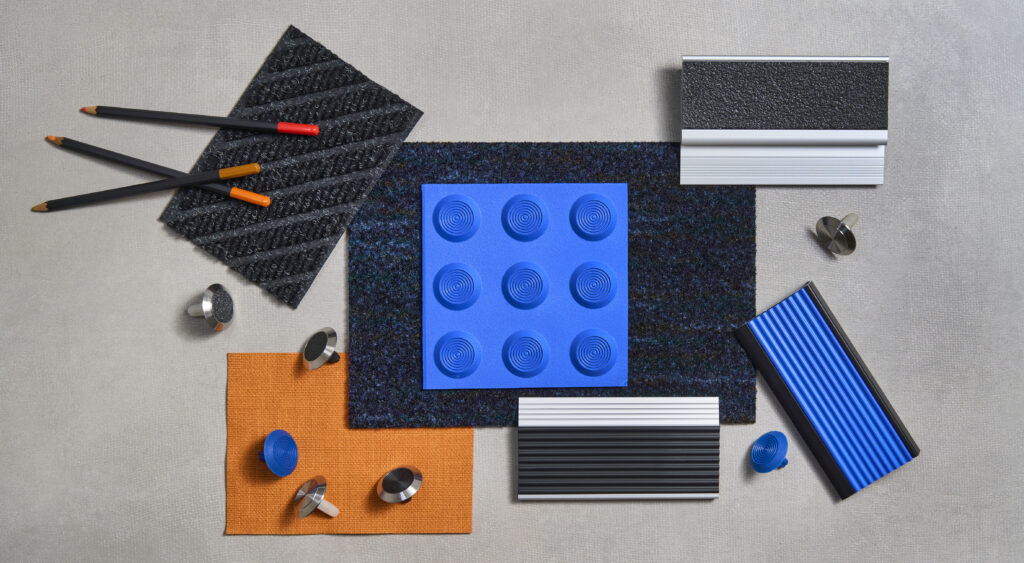
AS1428.1 addresses requirements for changes in floor level, including transitions between different flooring materials — at the leading edge, carpet trims and mat edges should have a vertical face no higher than 3mm or a rounded edge no higher than 5mm.
Aside from selecting the best entrance matting to enhance the appearance of a building’s entrance area, there should also be a clear visual contrast between the mats, floor surfaces and surrounding areas.
When selecting the colour of entrance matting, we recommend a high-contrast colour combination such as a natural aluminium mat frame combined with black or dark inserts.
Step 4: Correct Sizing & Placement
The entrance matting should cover the entire entry area to allow for two steps per foot, with sufficient length to maximise moisture absorption and dirt removal. It should also be installed to ensure smooth transitions without becoming a trip hazard or interfering with the operation of entrance doors.
At Classic, we recommend that matting extend at least 1.8 meters beyond the entrance doors on both sides or a greater distance if traffic naturally flows across the direction.
For traffic flow direction, a minimum of 3 meters is advised for low-traffic areas and between 6 to 10 meters for optimal performance in high-traffic zones.
Step 5: Choose a Compliant Supplier & Installer
We highly recommend working with suppliers and installers who understand the compliance requirements. With over 40 years’ experience, Classic Architectural Group can support you in designing, supplying, and installing our leading commercial entrance matting solutions for low, medium and high-traffic settings.

When you choose us, we’ll guide you through all the steps above to guarantee your project’s compliance.
Conduct Regular Upkeep to Ensure Ongoing Compliance
Beyond meeting matting installation regulations, it’s crucial to conduct regular inspections and maintenance to ensure continued accessibility and safety. Routine checks will help you promptly address any wear, damage, or deterioration that could compromise their performance over time.
Mats should be cleaned and vacuumed frequently, especially in high-traffic areas, to remove debris and moisture that could pose a slip hazard. If you notice the mat’s surface wearing down or edges curling, repair or replace them immediately to avoid non-compliance and prevent accidents.
In addition to enhancing safety, periodic inspection and maintenance of entrance mats will help extend the life of your flooring by preventing scratches, scuffs, and stains. This keeps the area looking clean and professional, ensuring a well-presented environment for all users.
Discover Architecturally Designed Commercial Entrance Mats at Classic
Classic Architectural Group’s entrance matting range is architecturally designed for commercial settings and comes in a versatile selection of colours, ensuring it seamlessly complements your project’s aesthetic.

To visualise how your preferred entrance mat will look and feel against your flooring, take advantage of Classic’s complimentary 3D/AR product visualisation tool.
Don’t slip up on your compliance; complete your project with our leading range of stair nosings, tactile indicators, car park fitout solutions, and more.
With over 40 years of experience in public access and safety solutions, Classic is the name you can trust. We offer end-to-end support, from consultation and design to manufacturing, supply, and installation Australia-wide, so that you can get a step ahead.
Download our latest product catalogue or speak with one of our friendly experts by calling 1300 244 377 today to get started.
